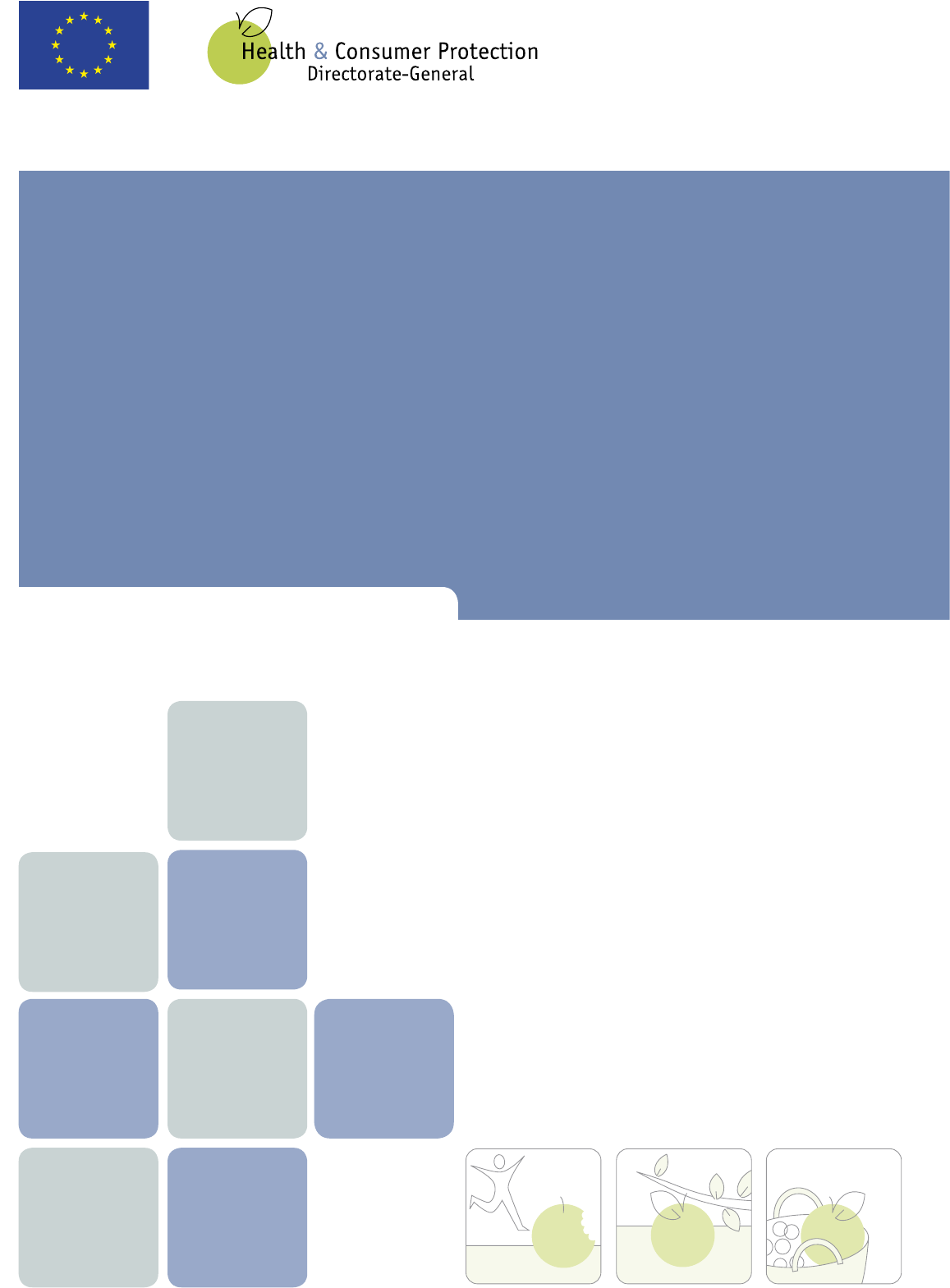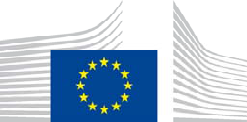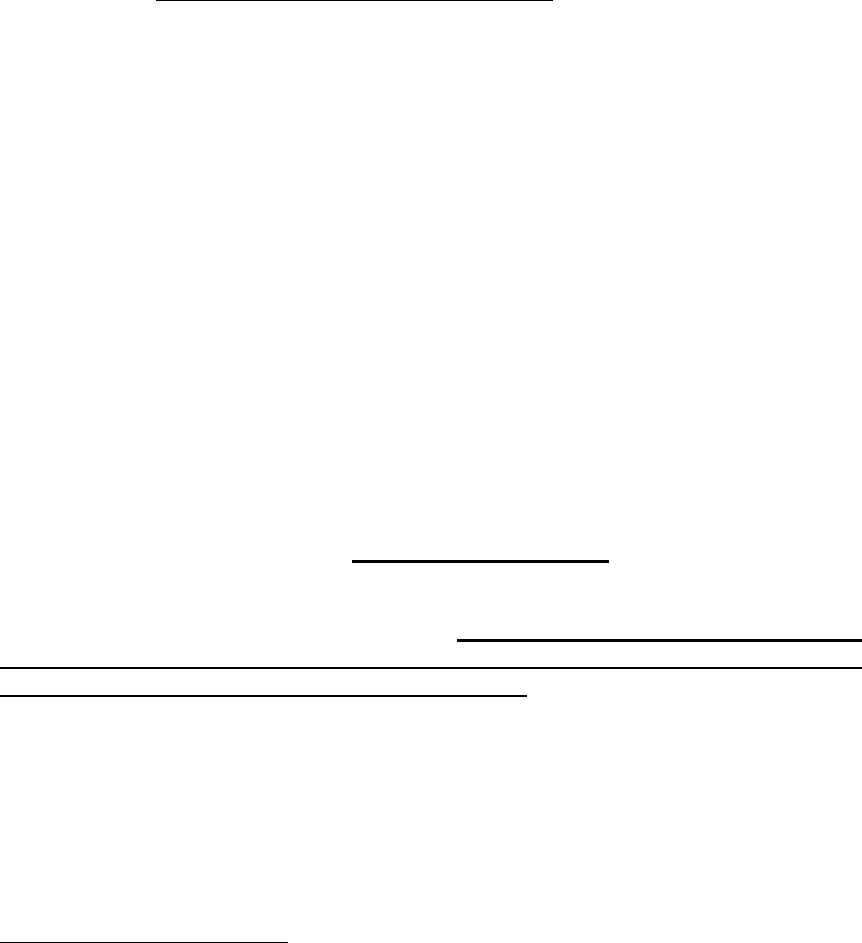
EUROPEAN COMMISSION
GUIDANCE DOCUMENT
Key questions related to import requirements
and the new rules on food hygiene and ofcial
food controls

EUROPEAN
COMMISSION
Brussels, XXX
[…](2013) XXX draft
SANCO/1446/2005 Rev.2014
(PLSPV/2005/1446/1446R4-EN.doc)
COMMISSION STAFF WORKING DOCUMENT
providing guidance on certain key questions related to import requirements
and the EU rules on food hygiene and on official food controls
EN EN

EN 2 EN
COMMISSION STAFF WORKING DOCUMENT
providing guidance on certain key questions related to import requirements
and the EU rules on food hygiene and on official food controls
PURPOSE OF THIS DOCUMENT
This document is mainly directed at competent authorities and food
businesses in the Member States and in third countries and aims to give
guidance on certain key questions with regard to the implementation of the
food hygiene import requirements and on related subjects.
NOTE
This document is an evolving document and will be updated to take account
of experiences and information from the Member States, from competent
authorities and food businesses in third countries, from food importers and
from the Food and Veterinary Office of the Commission's Health and
Consumers Directorate General.
The Court of Justice of the European Union constitutes the judicial authority of the EU
and is the institution which interprets European Union law as last resort.
EN 3 EN
Table of Contents
1. INTRODUCTION........................................................................................................ 5
2. GENERAL REMARKS............................................................................................... 6
3. FREQUENTLY ASKED QUESTIONS ...................................................................... 8
3.1. Must third countries, in order to be eligible for food exports to the EU have a
competent authority in place? ...................................................................................... 8
3.2. Must third countries, in order to be eligible for food exports be approved by the
EU?............................................................................................................................... 8
3.3. Must third countries, in order to be eligible for food exports have submitted a
control plan to the EU?................................................................................................. 8
3.4. Must food establishments in third countries, in order to be eligible for food
exports, be registered with the competent authority?................................................... 9
3.5. Must food establishments in third countries, in order to be eligible for food
exports, implement procedures based on the HACCP principles?............................... 9
3.6. Must third countries, in order to be eligible for export, have reference
laboratories in place?.................................................................................................... 9
3.7. What role will the Food and Veterinary Office of the Commission's Health and
Consumers Directorate General play?.......................................................................... 9
4. THE NOTIONS “FOOD”, “FOOD OF ANIMAL ORIGIN”, “FOOD OF NON-
ANIMAL ORIGIN” AND “COMPOSITE PRODUCTS” ........................................ 10
4.1. What is food? ............................................................................................................. 10
4.2. What is food of animal origin?................................................................................... 10
4.3. What is food of non-animal origin? ........................................................................... 10
4.4. What are composite products? ................................................................................... 10
5. GENERAL REQUIREMENTS FOR ALL FOOD.................................................... 10
5.1. Compliance or equivalence (Article 11 of Regulation (EC) No 178/2002)............... 10
5.2. Responsibilities of food importers (Article 19 of Regulation (EC) No 178/2002).... 11
5.3. General food hygiene requirements and microbiological criteria.............................. 11
6. IMPORTS OF FOOD OF NON-ANIMAL ORIGIN ................................................ 11
6.1. Import procedures ...................................................................................................... 11
6.2. Food of non-animal origin subject to increased level of controls.............................. 12
6.3. Food of non-animal origin subject to specific import requirements and to
specific import procedures ......................................................................................... 12
6.4. Sprouts and seeds intended for the production of sprouts.......................................... 12
7. IMPORTS OF FOOD OF ANIMAL ORIGIN, ......................................................... 13
7.1. Import procedures ...................................................................................................... 13
7.2. Specific food hygiene requirements........................................................................... 13
EN 4 EN
7.2.1. Obligations of importers (Article 6 of Regulation (EC) No 853/2004) ..................... 13
7.2.2. Obligations of competent authorities in third countries ............................................. 14
7.2.3. Transitional measures for import of certain food of animal origin ............................ 14
7.2.4. National public health import conditions and the principle of free movement.......... 15
8. IMPORTS OF COMPOSITE PRODUCTS............................................................... 16
8.1. Specific food hygiene requirements........................................................................... 16
8.2. Import procedure and certification of consignments of certain composite
products. ..................................................................................................................... 16

EN 5 EN
1. INTRODUCTION
Since the adoption of the rules on the hygiene of foodstuffs (Regulations (EC) No
852/2004, 853/2004 and 854/2004), and of the rules on officials controls (Regulation
(EC) No 882/2004, the Commission has been requested to clarify a number of aspects
related to food imports covered by these Regulations. This document aims to follow-up
these requests.
The Commission’s Health and Consumers Directorate General has held a series of
meetings with experts from the Member States in order to examine and reach consensus
on a number of issues concerning the implementation of the above Regulations.
In the interest of transparency, the Commission has also promoted discussion with
stakeholders so as to allow different socio-economic interests to express an opinion. To
this end the Commission has organised a meeting with representatives from producers,
industry, commerce and consumers to discuss issues related to the implementation of the
Regulations.
It was considered that these meetings and discussions should continue in the light of the
experience gained by the full application of the Regulations from 1 January 2006.
It should be noted that matters relating to the non-compliance of national legislation with
the Regulations remain outside the scope of this exercise and will continue to be dealt
with in accordance with established Commission procedures.
The present document aims to assist all players in the food chain to better understand and
to apply correctly and in a uniform way the Regulations. However, this document has no
formal legal status and in the event of a dispute, ultimate responsibility for the
interpretation of the law lies with the Court of Justice.
The main documents referred in this document are:
Regulation (EC) No 852/2004 of the European Parliament and of the
Council of 29 April on the hygiene of foodstuffs
1
,
Regulation (EC) No 853/2004 of the European Parliament and of the
Council of 29 April laying down specific hygiene rules for food of animal
origin
2
,
1
OJ L 226, 25.6.2004, p. 3.
2
OJ L 226, 25.6.2004, p. 22.

EN 6 EN
Regulation (EC) No 178/2002 of the European Parliament and of the
Council laying down the general principles and requirements of food law,
establishing the European Food Safety Authority and laying down
procedures in matters of food safety
3
(also referred to as the General Food
Law), and
Regulation (EC) No 882/2004 of the European Parliament and of the
Council of 29 April 2004 on official controls performed to ensure the
verification of compliance with feed and food law, animal health and
animal welfare
4
.
A separate guidance document has been established on Regulations (EC) Nos 178/2002,
852/2004, 853/2004 and on flexibility with regard to HACCP-based systems and small
and medium size enterprises.
(See http://ec.europa.eu/food/food/biosafety/hygienelegislation/index_en.htm)
2. GENERAL REMARKS
In the EU the food hygiene import systems for food of animal origin (such as meat, fish
and dairy products) are not entirely the same as for food of non-animal origin (such as
fruit, vegetables) or as for food containing both processed ingredients of animal origin
and ingredients of plant origin etc.
This document aims to clarify in general terms and with regard to food hygiene, the
import systems for different food commodities, and in particular for:
Food of non-animal origin,
Food of animal origin, and
Food containing both processed ingredients of animal origin and
ingredients of plant origin.
The food hygiene conditions for food imports are laid down in several parts of EU law.
Apart from Regulations (EC) Nos 852/2004, 853/2004, 178/2002 and 882/2002,
consideration should be given to:
Regulation (EC) No 854/2004 of the European Parliament and of the
Council of 29 April 2004 laying down specific rules for the organisation
of official controls on products of animal origin intended for human
consumption
5
Council Directive 97/78/EC of 18 December 1997 laying down the
principles governing the organisation of veterinary checks on products
entering the Community from third countries
6
.
This document supplements other guidance documents and in particular:
3
OJ L 31, 1.2.2002, p. 1.
4
OJ L 191, 28.5.2004, p. 1.
5
OJ L 226, 25.6.2004, p.83.
6
OJ L 24, 30.1.1998, p.9.

EN 7 EN
A dedicated website which offers advice as well as assistance to third
country trading partners intending to import food:
http://ec.europa.eu/food/international/trade/index_en.htm
Guidelines on the implementation of the main General Food Law
requirements:
http://ec.europa.eu/food/food/foodlaw/guidance/index_en.htm
Importers of food need to consider also other requirements that need to be complied with:
Other health requirements
Under relevant requirements of EU food law, a number of rules
apply that complement or are in addition to food hygiene. These
include in particular and where appropriate requirements
concerning:
○ Contaminants,
○ Maximum residue levels for pesticides,
○ The use of food additives, enzymes and flavourings,
○ Materials and articles in contact with foodstuffs,
○ Food irradiation,
○ Novel foods,
○ Radioactivity.
Product specific requirements also exist concerning:
○ Quick frozen foodstuffs,
○ Foodstuffs for particular nutritional purposes,
○ Genetically modified organisms (GMOs),
○ Approved residue control plans.
For more information, see:
http://ec.europa.eu/food/food/index_en.htm
Plant health requirements
Before they can be introduced into the EU, certain plants, plant products or other objects
must comply with phytosanitary requirements.
For more information, see: http://ec.europa.eu/food/plant/index_en.htm
Animal health requirements
Products of animal origin from third countries must comply with requirements that
prevent the introduction of animal diseases into the EU. These requirements emanate
from Council Directive 2002/99/EC of laying down the animal health rules governing the
production, processing, distribution and introduction of products of animal origin for
human consumption
7
. For more information, see:
http://ec.europa.eu/food/animal/animalproducts/index_en.htm
7
OJ L 18, 23.1.2003, p. 11.

EN 8 EN
The provisions in the hygiene regulations may be supplemented by additional animal
health requirements or other provisions, such as the ones on novel food (Regulation (EC)
No 258/97 of the European Parliament and of the Council of 27 January 1997 concerning
novel foods and novel food ingredients
8
).
3. FREQUENTLY ASKED QUESTIONS
3.1. Must third countries, in order to be eligible for food exports to the EU have
a competent authority in place?
Regulation (EC) No 882/2004 does not require third countries to have competent
authorities in place. However, more specific veterinary and phytosanitary legislation
requires that competent authorities must have been established. In general the following
applies:
With regard to food of animal origin, the EU has always taken into
consideration the guarantees on compliance with EU food law given by the
competent authorities in third countries.
With regard to food of non-animal origin:
○ As far as phytosanitary requirements are concerned, the need for a
competent authority is spelled out in the relevant legislation.
○ Compliance with EU requirements other than phytosanitary ones has been
ensured in most cases by non governmental bodies and imports were
allowed upon the guarantees offered by the importer of the food into the
EU.
3.2. Must third countries, in order to be eligible for food exports be approved
by the EU?
With regard to food of animal origin only a third country that appears on a list
established by the EU can export to the EU.
With regard to food of non-animal origin, third countries do not need to appear on a list
for being eligible for export to the EU.
3.3. Must third countries, in order to be eligible for food exports have submitted
a control plan to the EU?
Regulation (EC) No 882/2004 does not require third countries to submit a control plan.
Regulation (EC) No 882/2004 authorises the Commission to request third countries to
provide accurate and up-to-date information on their sanitary and phytosanitary
regulations, control procedures and risk assessment procedures with regard to products
exported to the EU.
This is fully in line with Article 7 and Annex B of the World Trade Organisation’s
Agreement on the Application of Sanitary and Phytosanitary Measures (15 April 1994)
9
.
It must be borne in mind that EU food law requires mandatory submission of information
with respect to:
8
OJ L 43, 14.2.1997, p. 1.
9
Published on http://www.wto.org/english/tratop_e/sps_e/spsagr_e.htm

EN 9 EN
Residues of veterinary medicinal products and other pharmacological
active substances used to treat animals.
Zoonotic diseases.
3.4. Must food establishments in third countries, in order to be eligible for food
exports, be registered with the competent authority?
With regard to food of animal origin, in most cases only products from
establishments (including factory and freezer vessels) that appear on a list
approved by the EU can export to the EU.
With regard to food of non-animal origin, it is in many cases sufficient that
exporting establishments in third countries are known to and accepted as
suppliers by importers of food into the EU. For consignments containing plants
or plant products which are covered by the EU plant health acquis, the exporter
must obtain a phytosanitary certificate issued by his competent national
authorities. This will normally involve registration (see under 6.5).
3.5. Must food establishments in third countries, in order to be eligible for food
exports, implement procedures based on the HACCP principles?
The competent authorities in the Member States have to ensure that foodstuffs imported
into the EU are submitted to official controls for the purpose of ensuring that the relevant
provisions of the food hygiene rules, including the requirement of putting in place,
implementing and maintaining HACCP-based procedures are observed.
The EU rules on food hygiene confirm that all food businesses in third countries after
primary production must put in place, implement and maintain a procedure based on the
HACCP principles. These rules are flexible, as the HACCP based procedures can be
adapted to all situations.
3.6. Must third countries, in order to be eligible for export, have reference
laboratories in place?
There is no requirement for third countries to have reference laboratories.
However, Regulation (EC) No 882/2004 requires laboratories that are engaged in
verifying compliance with EU food standards to be accredited.
Such laboratories may be private laboratories that have been designated for the purpose
of verifying compliance with EU food standards by the body in charge of official
controls.
In order to facilitate the accreditation of laboratories, the Commission has adopted a
Regulation that grants a transitional period during which laboratories in third countries
can adapt to the new situation.
3.7. What role will the Food and Veterinary Office of the Commission's Health
and Consumers Directorate General play?
The Food and Veterinary Office (FVO) carries out audits in both Member States and
third countries.
However, the Commission is responsible under Regulation (EC) No. 882/2004 for
requesting third countries intending to export food to the EU to provide accurate and up-
to-date information on the general organisation and management of sanitary control
systems.

EN 10 EN
The natural contact point for the Commission in third countries is the competent
authority. In practice, initial requests for information will be addressed to the
representation of the third country in the EU. Depending on the reply given by the third
country, further contacts will be either directly with the competent authority(ies) in the
third country concerned and/or with the relevant control body.
4. THE NOTIONS “FOOD”, “FOOD OF ANIMAL ORIGIN”, “FOOD OF
NON-ANIMAL ORIGIN” AND “COMPOSITE PRODUCTS”
In EU law, the requirements and introduction procedures for importing food of non-
animal origin, food of animal origin and composite products are different. It is important
therefore to have an understanding of what these notions include.
4.1. What is food?
Food is defined in Article 2 of Regulation (EC) No 178/2002.
4.2. What is food of animal origin?
The notion “food of anim
al origin” covers food that has been derived from animals or
coming from animals, whether processed or not. In certain cases this may include live
animals (e.g. lobsters or live bivalve molluscs) that are placed on the market for
consumption.
Annex I gives a general (non-exhaustive) overview of what is to be considered as food of
animal origin.
4.3. What is food of non-animal origin?
Food of non-anim
al origin includes items such as fruits, vegetables, cereals, tubers,
drinks, (apart from drinks prepared from or including products of animal origin such as
milk or egg products and certain milk based drinks), food of mineral origin (such as
salt), spices, condiments etc.
4.4. What are composite products?
For food hygiene purposes, food containing both products of plant origin and processed
products of animal origin are called “composite products”.
Sections 5, 6, 7 and 8 of this document give the essential elements that must be taken into
account when importing food of non-animal origin, food of animal origin and composite
products respectively into the EU.
5. GENERAL REQUIREMENTS FOR ALL FOOD
Certain basic food law and food hygiene requirements applying to all food are laid down
in Regulation (EC) No 178/2002 and Regulation (EC) No 852/2004, respectively. These
include in particular:
5.1. Compliance or equivalence (Article 11 of Regulation (EC) No 178/2002)
Food imported into the EU for placing on the market within the EU shall comply with:
The relevant requirements of food law, or
Conditions recognised by the EU to be at least equivalent thereto, or

EN 11 EN
Where a specific agreement exists between the EU and the exporting
country, with requirements contained therein.
5.2. Responsibilities of food importers (Article 19 of Regulation (EC)
No 178/2002)
If a food business operator considers or has reason to believe that a food which it has
imported is not in compliance with the food safety requirements, it shall immediately
initiate procedures to withdraw the food in question from the market where the food has
left the immediate control of that initial food business operator and inform the competent
authorities thereof.
5.3. General food hygiene requirements and microbiological criteria
The relevant requirements with regard to the hygiene of all food are contained in Articles
3 to 6 of Regulation (EC) No 852/2004, which means that the following rules need to be
respected by all food business operators in third countries:
A general obligation on the operator to monitor the food safety of products
and processes under his responsibility (Article 3 of Regulation (EC)
No 852/2004),
General hygiene provisions for primary production (Article 4.1 of, and
Part A of Annex I to Regulation (EC) No 852/2004),
Detailed requirements after primary production (Article 4.2 of and Annex
II to Regulation (EC) No 852/2004),
For certain products, microbiological requirements (Article 4.3 of
Regulation (EC) No 852/2004) and Commission Regulation (EC)
No 2073/2005 of 15 November 2005 on microbiological criteria for
foodstuffs
10
,
Procedures based on the HACCP principles (Article 5 of Regulation (EC)
No 852/2004) ,
Registration or approval of establishments (Article 6 of Regulation (EC)
No 852/2004).
6. IMPORTS
OF FOOD OF NON-ANIMAL ORIGIN
6.1. Import procedures
When i
mporting food of non-animal origin, it is incumbent upon the importer to
ensure compliance with the relevant requirements of EU food law or with
conditions recognised equivalent thereto by the EU.
Most (see points 6.2, 6.3 and 6.4) food of non-animal origin can enter the EU
through any entry point and is not subject to specific import conditions, pre-
notification requirement or certification by the competent authorities of the third
country of dispatch.
Food of non-animal origin may be submitted to controls in accordance with a
control plan drawn up in the light of potential risks (see Article 15, paragraph 1
of Regulation (EC) No 882/2004). Such controls must take place in accordance
10
OJ L 338, 22.12.2005, p. 1.

EN 12 EN
with national law in the different Member States. This may be at the point of
entry, the point of release for free circulation, the importer’s premises, retail
outlets etc.
6.2. Food of non-animal origin subject to increased level of controls
In accordance with Article 15, paragraph 5 of Regulation (EC) No 882/2004, the
Commission established a list of food of non-animal origin that, on the basis of known or
emerging risks, must be subjected to an increased level of official controls upon
introduction into the EU.
For such food, the following would apply:
Particular points of entry shall be designated,
Food business operators shall give prior notification of the arrival of the goods
and of their nature to the competent authority at the point of entry into the EU.
The list of the products subject to controls at the point of entry into the EU has been laid
down in Annex I to Commission Regulation (EC) No 669/2009 of 24 July 2009
implementing Regulation (EC) No 882/2004 of the European Parliament and of the
Council as regards the increased level of official controls on imports of certain feed and
food of non-animal origin and amending Decision 2006/504/EC
11
and can be consulted
at:
http://ec.europa.eu/food/food/controls/increased_checks/index_en.htm
6.3. Food of non-animal origin subject to specific import requirements and to
specific import procedures
In application of Article 53 of Regulation (EC) 178/2002, safeguard measures have been
taken as regards the import of certain food of non-animal origin from certain third
countries imposing special condtions to the import of these products into the Union.
6.4. Sprouts and seeds intended for the production of sprouts
Apart from the above requirem
ents on food of non-animal origin, certification applies to
the import of consignments of sprouts or seeds intended for the production of sprouts,
excluding sprouts which have undergone a treatment which aliminates the
microbiological hazards (for example canned (pasteurized) sprouts) in accordance with
Commission Regulation (EU) No 211/2013 of 11 March 2013 on certification
requirements for imports into the Union of sprouts and seeds intended for the production
of sprouts
12
.
Apart from the requirement in section 5 and 6.1, certification is needed as regards
provisions on:
Traceability in accordance with Commission Regulation (EU) No 208/2013 of
11 March 2013 on traceability requirements for sprouts and seeds intended for the
production of sprouts
13
.
11
OJ L 194, 25.7.2009, p. 11.
12
OJ L 68, 12.3.2013, p. 26.
13
OJ L 68, 12.3.2013, p. 16.

EN 13 EN
Approval of establishments producing sprouts in accordance with Commission
Regulation (EU) No 210/2013 of 11 March 2013 on the approval of
establishments producing sprouts pursuant to Regulation (EC) No 852/2004 of
the European Parliament and of the Council
14
.
7. IMPORTS OF FOOD OF ANIMAL ORIGIN,
7.1. Import procedures
In accordance with Directive 97/78/EC and Commission Regulation (EC) No 136/2004
of 22 January 2004 laying down procedures for veterinary checks at Community border
inspection posts on products imported from third countries
15
:
Products of animal origin, must be presented at an EU approved border
inspection post for being submitted to an import control,
Prior notification of the physical arrival of the products on the EU territory must
be provided to the border inspection post of arrival using the Common
Veterinary Entry Document (CVED),
The consignments must be presented to the border inspection post accompanied
by all relevant certificates/documents required in EU legislation,
Consignments will only be accepted if the products are derived from approved
third countries, regions thereof and establishments as appropriate and if
veterinary checks had favourable results,
In certain cases, safeguard measures introducing special import conditions or
restrictions may apply,
The procedures as laid down in Regulation (EC) No 136/2004 are to be
followed.
Additional information regarding import controls in border inspection posts is available
at: http://ec.europa.eu/food/animal/bips/index_en.htm
7.2. Specific food hygiene requirements
It should be noted that when the hygiene package (including implementing acts such as
Regulation (EC) No 2073/2005) came into force, the previous specific public health
conditions on imports of food of animal origin based on Council Directive 92/118/EEC
of 17 December 1992 laying down animal health and public health requirements
governing trade in and imports into the Community of products not subject to the said
requirements laid down in specific Community rules referred to in Annex A (I) to
Directive 89/662/EEC and, as regards pathogens, to Directive 90/425/EEC
16
(Annex II)
were among those repealed.
7.2.1. Obligations of importers (Article 6 of Regulation (EC) No 853/2004)
Food business operators importing food of animal origin must ensure that the products:
Come from a third country or a part of a third country that appears on an EU list,
Where applicable, come from an establishment that appears on an EU list,
14
OJ L 68, 12.3.2013, p. 24.
15
OJ L 21, 28.1.2004, p.11
16
OJ L 62, 15.3.1993, p. 49.

EN 14 EN
Where applicable, carry a health or identification mark,
Where applicable, are accompanied by a certificate issued by the representative
of the competent authority of the third country,
Are made available for control in an EU approved border inspection post,
Comply with the animal health requirements of Council Directive 2002/99/EC,
Operations carried out under their control that take place after importation are
carried out in accordance with the appropriate requirements of Regulation (EC)
No 853/2004.
7.2.2. Obligations of competent authorities in third countries
For food of animal origin, EU food law requires that the competent authority of the
exporting country offers guarantees as to the compliance or equivalence with EU
requirements. The competent authorities in the exporting third country shall in particular
ensure that:
Their control services comply with the operational criteria laid down in EU law,
in particular in Regulation (EC) No 882/2004,
The establishments that are authorised to export to the EU comply and continue
to comply with the EU requirements and that the list of such establishments is
kept up-to-date and communicated to the Commission (Article 12, paragraph 2
of Regulation (EC) No 854/2004),
The certification requirements are satisfied. Common (e.g. including animal
health requirements) model certificates have been made available for almost all
food for which specific requirement have been laid down in Annex III to
Regulation (EC) No 853/2004.
As regards food of animal origin not covered by Annex III to Regulation (EC) No
853/2004, an EU list of eligible countries and the model health certificate have been laid
down for honey (apiculture products).
The models can be found at: http://ec.europa.eu/food/international/trade/index_en.htm
Further details are laid down in Annex VI to Regulation (EC) No 854/2004 (e.g. that the
certificate must be issued before the consignment to which it relates leaves the control of
the competent authority or the third country of dispatch).
7.2.3. Transitional measures for import of certain food of animal origin
Im
port conditions for food of animal origin are considered fully harmonised at EU level
if for the relevant food, the import conditions include the presence of:
a) An EU list of eligible third countries
b) A model health certificate (public health statements often combined with animal
health statements in the same certificate)
c) An EU list of eligible establishments in third countries (only for establishments
falling under Annex II to Regulation (EC) No 852/2004 and for which Annex III to
Regulation (EC) No 853/2004 lays down requirements).

EN 15 EN
For certain food of animal origin, the lists of eligible countries, the model certificates
and/or the lists (if required) of eligible establishments have not yet been established at
EU level (insects, meat of marine mammals , meat of reptiles, …). Therefore, transitional
provisions apply until 31 December 2016
17
.
During the transitional period, until the eventual adoption of harmonised EU import
conditions, all imported food of animal origin must comply with the requirements of
Regulation (EC) No 178/2002 (see section 5), and Regulation (EC) No 852/2004 (see
Section 5.3). Imported food of animal origin must also comply with other conditions for
food safety, if laid down in specific EU legislation applicable for certain food, such as,
official controls for Trichinella according to Regulation (EC) No 2075/2005 of 5
December 2005 laying down specific rules on official controls for Trichinella in meat
18
,
residue programmes according to Commission Decision 2011/163/EU of 16 March 2011
on the approval of plans submitted by third countries in accordance with Article 29 of
Council Directive 96/23/EC
19
, the TSE legislation (Regulation (EC) No 999/2001 of the
European Parliament and of the Council of 22 May 2001 laying down rules for the
prevention, control and eradication of certain transmissible spongiform
encephalopathies
20
), and specific safeguard measures. In line with general EU principles,
it is the responsibility of the food business operators importing food of animal origin
from third countries to ensure that importation takes place only if the product complies
with these EU requirements. In addition, it is the responsibility of competent authorities
in third countries to verify that food business operators exporting to the EU took their
respective responsibility ensuring that exported products fulfil EU requirements.
The Commission is reflecting on a future solution for all food of animal origin to better
clarify the import requirements for various types of products. before the end of the
transitional period. The EU listing of establishments and the adoption of EU model
certificates will, in any case, be continued as quickly as possible for food of animal origin
for which specific requirements are laid down in Annex III to Regulation (EC) No
853/2004.
7.2.4. National public health import conditions and the principle of free movement
In principle, a product lawfully marketed in one Member State can be placed on the
market in all Member States. An exception to this general rule is that, according to
Article 36 of the Treaty on the Functioning of the EU
21
, restrictions on trade between
Member States can be justified, inter alia, for public morality or public health reasons,
the protection of health and life of humans, animals and plants. However, since these
restrictions are exceptional derogations from the principle of free movement, they must
be thoroughly justified. Normally, serious risks are addressed by EU provisions ensuring
the same high level of protection within the EU.
For food of animal origin for which full EU harmonisation (See 7.2.3) has not been
completed yet, national public health import conditions may apply. However, before
17
Commission Regulation (EU) No 1079/2013 of 31 October 2013 laying down transitional
measures for the application of Regulations (EC) No 853/2004 and (EC) No 884/2004 of the
European Parliament and of the Council.
18
OJ L 338, 22.12.2005, p. 60.
19
OJ L 70, 17.3.2011, p. 40.
20
OJ L 147, 31.5.2001, p. 1.
21
http://eur-lex.europa.eu/LexUriServ/LexUriServ.do?uri=OJ:C:2010:083:0047:0200:en:PDF

EN 16 EN
laying down trade-restrictive national legislation, such national legislation must be
notified at draft stage in accordance with the procedure under Directive 98/34/EC of the
European Parliament and of the Council of 22 June 1998 laying down a procedure for the
provision of information in the field of technical standards and regulations
22
. In doing so,
the Commission and other Member States shall have the possibility to provide comments
on the possible restrictions on trade and import. Upon the successful completion of the
notification procedure, these national rules must be complied with when placing the
relevant food only on the market of the notifying Member State.
Member States importing food of animal origin for which full EU harmonisation has not
been completed yet, do not need to lay down national rules for the application of the
existing general EU import requirements (for instance, Regulation (EC) No 178/2002, or
Regulation (EC) No 852/2004), as provisions in these EU Regulations are directly
applicable. Only if additional national import requirements are laid down (see previous
paragraph), cross-references to the relevant EU provisions should be made in the national
rules without repeating the EU provisions and above mentioned notification under
Directive 98/34/EC is required.
Regarding which national rules have to be notified, it should be observed that only the
national rules themselves must be notified. For instance, national lists of eligible third
country establishments which were established following these national rules should not
be notified.
8. IMPORTS OF COMPOSITE PRODUCTS
8.1. Specific food hygiene requirements
In accordance with Article 6, paragraph 4 of Regulation (EC) No 853/2004, food
business operators established in the EU and importing food containing both products of
plant origin and processed products of animal origin must ensure that the processed
components of animal origin contained in such food satisfy the specific requirements
for products of animal origin in section 7.2.
The importing food business operator must be able to demonstrate that the above is
respected (using documentation or otherwise).
8.2. Import procedure and certification of consignments of certain composite
products.
Certain composite products provided for in Regulation (EU) No 28/2012 of 11
January 2012 laying down requirements for the certification for imports into and
transit through the Union of certain composite products and amending Decision
2007/275/EC and Regulation (EC) No 1162/2009
23
have to undergo import
controls in border inspection posts as described in section 7.1.
The same Regulation specifies certification requirements taking into
consideration animal and public health requirements.
22
OJ L 204, 21.7.1998, p. 37.
23
OJ L 12, 14.1.2012, p. 1.

EN 17 EN
FOOD OF ANIMAL ORIGIN
I. Non-exhaustive list of non-processed food of animal origin
– Fresh meat (meat of domestic ungulates, poultry meat, meat
from lagomorphs, wild game meat, farmed game meat and
other meat)
– Minced meat
– Meat preparations
– Mechanically Separated Meat
– Blood
– Fish and crustaceans (including live fish and crustaceans)
– Live bivalve molluscs, live echinoderms, live tunicates and live
marine gastropods
– Raw milk
– Eggs
– Frogs’ legs
– Snails
– Honey
– Other
A non-processed food of animal origin associated with a product of
plant origin remains a non-processed product of animal origin e.g.
– skewer containing fresh meat and vegetables
– preparations of fresh fishery products (e.g. fish fillets) with
food of plant origin

EN 18 EN
II. Non-exhaustive list of processed food products of animal origin
Processed products are obtained by submitting raw material of animal
origin to a process such as heating, smoking, curing, salting, maturing,
drying, marinating, etc
Processed products include:
– Meat products (ham, salami,)
– Fish products (smoked fish, marinated fish etc)
– Milk products (heat treated milk, cheese, yoghurt,)
– Egg products
– Rendered animal fat
– Greaves
– Gelatine
– Collagen
– Treated stomachs and bladders etc.
Processed products also include:
Combinations of processed products e.g. cheese with ham
Products obtained after further processing of already
processed products
.
Products to give special characteristics may be added e.g.
– sausage with garlic
– yoghurt with fruit
– cheese with herbs
– ice cream with chocolate
